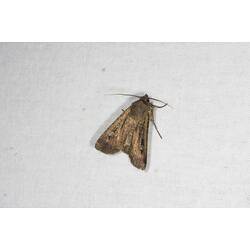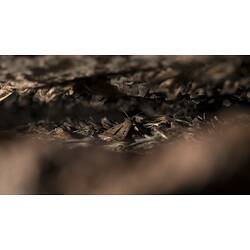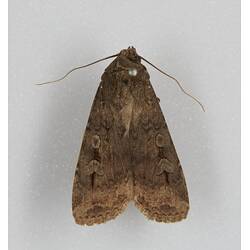General Description
Forewings have a distinctive section with a longitudinal streak with a circle at the front and a kidney shape at the other end. There is a light brown form and a much darker form. Male has feathered antennae, female threadlike. Medium sized moth with wingspan up to 35 mm.
Biology
Bogong moths may live several months and are strong migrants. In high summer tens of thousands rest in a state of dormancy (aestivate) in crevices on alpine peaks before returning to breeding grounds. Larvae feed on a wide range of native grasses. They can also devastate pastures including wheat, pea, silver beet and other crops.
Distribution
New Zealand, Norfolk Island and Southern Australia including Victoria and Tasmania.
Habitat
Adults can be found in most habitats.
More Information
-
Animal Type
-
Animal SubType
-
Brief Id
Brown moth with distinctive forewings bearing a longitudinal streak with a circle at the front and a kidney shape at the other end.
-
Colours
Grey-brown
-
Maximum Size
35 mm
-
Habitats
Alpine, DryForest, Grassland, Mallee, Urban, WetForest, Woodland
-
Diet
Herbivore
-
Diet Categories
Nectar, Grasses
-
Endemicity
-
Commercial
No
-
Conservation Statuses
CITES: Not listed, FFG Threatened List: Not listed, EPBC Act 1999: Not listed, IUCN Red List: Endangered
-
Flight Start
September
-
Flight End
November
-
Taxon Name
-
Scientific Author
(Boisduval, 1832)
-
Common Name
Bogong Moth
-
Kingdom
-
Phylum
-
Subphylum
-
Superclass
-
Class
-
Order
-
Family
-
Subfamily
-
Genus
-
Species Name
infusa





